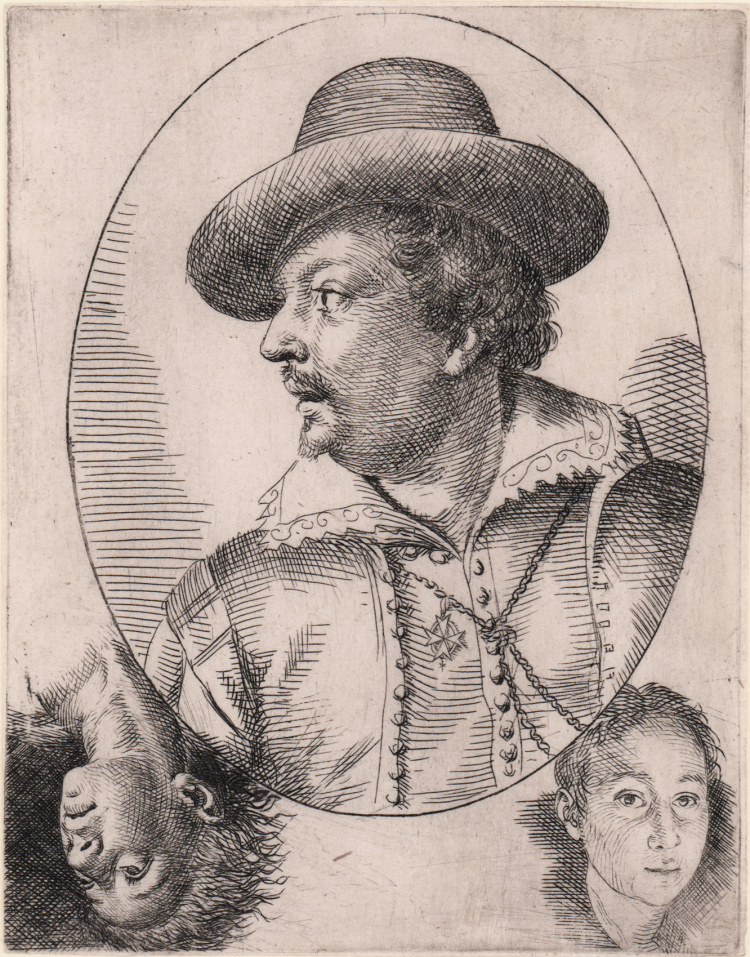




| Reference: | S26715 |
| Author | Ottavio LEONI detto "Il Padovanino" |
| Year: | 1625 |
| Measures: | 111 x 140 mm |



| Reference: | S26715 |
| Author | Ottavio LEONI detto "Il Padovanino" |
| Year: | 1625 |
| Measures: | 111 x 140 mm |
Etching and engraving, 1625, unlettered.
A magnificent impression of the rare first state of two, before the letters, printed on contemporary laid paper, trimmed to the platemark, in excellent condition.
Famous for his portraits of all the Roman aristocracy in the early 17th century, the Roman-born Leoni owes his nickname to the birthplace of his father, who was also a portrait painter.
The identity of the face depicted is controversial: according to Mariette, a great fan of Leoni's drawings and engravings, it is Mario Nuzzi, known as "Mario de' Fiori", while it is more likely to be his friend Tommaso Salini, a hypothesis confirmed by the legend added on the examples of the second state.
On either side of the main portrait is a curious juxtaposition of two engraved heads, confirming the fact that the plate was not commissioned.
Ottavio Leoni was the son of the Paduan-born Ludovico Leoni (1542–1612), a maker of medals and wax relief portraits. Although Ottavio was active entirely in Rome, where his father had also worked and died, he was often known as ‘il Padovanino’ because of the family origins. In 1603 Ottavio was involved in a libel action against Caravaggio by the painter Giovanni Baglione, whose life provides the best source of information on Leoni’s life. One witness at the trial, Tommaso Salini, claimed he had received verses criticizing Baglione written by Orazio Gentileschi and ‘Ottavio Padovano’. Caravaggio testified that he knew Leoni without having ever spoken to him.
The following year Leoni was admitted to the Accademia di S Luca in Rome and in 1614 became its principal. It was at this time, according to Baglione, that he painted two canvases, a Martyrdom of St Martina and an Ascension (both untraced). In 1621 Leoni became a member of the Accademia dei Virtuosi del Pantheon, the body to which he presented in 1628 an oil portrait of Gregory XV.
He portrayed the faces of early 17th century Rome on an endless number of sheets of blue paper: popes, cardinals, noblemen and ladies, but also scientists, mathematicians, artists and poets. His portraits known as "alla macchia" (Baglione, p. 321), i.e. drawn from memory after having seen the model almost in passing, won a very wide public for their extraordinary realistic rendering, to which the artifice of the à trois crayons technique (black pencil, sanguine and white chalk) certainly contributed.
Bibliografia
Bartsch 7 I/II; Petrucci, Il Caravaggio acquafortista, pp. 35/46.
Ottavio LEONI detto "Il Padovanino" (Roma 1578 circa - 1630)
|
Italian draughtsman, printmaker and painter. He was the son of the Paduan-born Ludovico Leoni (1542–1612), a maker of medals and wax relief portraits. Although Ottavio was active entirely in Rome, where his father had also worked and died, he was often known as ‘il Padovano’ because of the family origins. In 1603 Ottavio was involved in a libel action against Caravaggio by the painter Giovanni Baglione, whose life provides the best source of information on Leoni’s life. One witness at the trial, Tommaso Salini, claimed he had received verses criticizing Baglione written by Orazio Gentileschi and ‘Ottavio Padovano’. Caravaggio testified that he knew Leoni without having ever spoken to him. The following year Leoni was admitted to the Accademia di S Luca in Rome and in 1614 became its principal. It was at this time, according to Baglione, that he painted two canvases, a Martyrdom of St Martina and an Ascension (both untraced). In 1621 Leoni became a member of the Accademia dei Virtuosi del Pantheon, the body to which he presented in 1628 an oil portrait of Gregory XV (in situ).
|
Ottavio LEONI detto "Il Padovanino" (Roma 1578 circa - 1630)
|
Italian draughtsman, printmaker and painter. He was the son of the Paduan-born Ludovico Leoni (1542–1612), a maker of medals and wax relief portraits. Although Ottavio was active entirely in Rome, where his father had also worked and died, he was often known as ‘il Padovano’ because of the family origins. In 1603 Ottavio was involved in a libel action against Caravaggio by the painter Giovanni Baglione, whose life provides the best source of information on Leoni’s life. One witness at the trial, Tommaso Salini, claimed he had received verses criticizing Baglione written by Orazio Gentileschi and ‘Ottavio Padovano’. Caravaggio testified that he knew Leoni without having ever spoken to him. The following year Leoni was admitted to the Accademia di S Luca in Rome and in 1614 became its principal. It was at this time, according to Baglione, that he painted two canvases, a Martyrdom of St Martina and an Ascension (both untraced). In 1621 Leoni became a member of the Accademia dei Virtuosi del Pantheon, the body to which he presented in 1628 an oil portrait of Gregory XV (in situ).
|